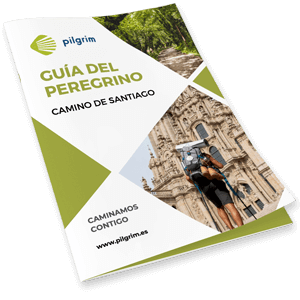- Index
- What is the Iron Cross?
- Where is the Iron Cross?
- Cruz de Ferro as a ”humilladero”: where does the tradition come from?
One of the most emblematic places on the Camino de Santiago is the point where the Cruz de Ferro (or Iron Cross) is located, the largest humilladero in Europe where each pilgrim deposits a stone on their way.
We tell you all about this symbol, its relevance, origin and exact location in the province of León, at an important point of the French Way.
What is the Iron Cross?
One of the best known symbols of the Camino de Santiago (although in many cases only for those who dare to do the French Way) is the Iron Cross, also known as Cruz de Ferro in Galician, or Cruz de Fierro in Leonese.
This cross is a very mythical symbol of the Camino de Santiago, although it is not considered a monument like the Pilgrims’ Monument, located on Monte do Gozo and created expressly as a tribute to the pilgrims. This symbol of the Camino de Santiago is simply a wooden post about 5 metres high with an iron cross at the top.
The iron cross that we find crowning this mast today, however, is a replica of the original, which is kept in the Museo de los Caminos, located in Astorga.
Where is the Iron Cross?
This mythical cross is a very important symbol of the Way of St. James and is located on Mount Irago in the province of León, between the villages of Foncebadón and Manjarín, at an altitude of 1500 metres. This is, in fact, the highest point of the French Way, except for those who do the Aragonese Way and pass through the Somport pass, which is at more than 1600 metres.
The fact that it is located at the highest point of the Camino de Santiago is no coincidence. Neither it is the fact that is located between two regions as different as El Bierzo and Maragatería, or between the basins of the Duero and the Miño, two of the most important rivers in this part of the peninsula.
A few metres away and due to the importance of this symbol on the Camino, a chapel was built in the 1980s, dedicated of course to the Apostle St. James, as well as a fountain that pilgrims use to refresh themselves and take a break.
Cruz de Ferro as a ”humilladero”: where does the tradition come from?
The history of this iron cross is not very clear. Some people go back to the Celtic world and suggest that this place was used for the worship of the ancient gods, and that it was later Christianised with the placing of the cross.
However, there are also those who believe that its birth dates back to the Roman Empire, as a landmark that marked the separation between two different territories as well as a place where the spirits of the dead could dwell. As a superstition and as a way of respecting these spirits, the walkers began to leave stones in their path as an offering, creating small mounds known as humilladeros.
However, the more practical origin of this symbol is also said to be simply to continue signalling the Camino de Santiago when heavy snowfalls occurred that could lead walkers astray. It is said that it was the hermit Gaucelmo, the same hermit who built a hostel to give shelter to pilgrims in Foncebadón, who placed the first cross on this post to turn it into a reference point.
Be that as it may, the Iron Cross has become an important point on the Camino, known by many pilgrims and especially by those who find it on their way through these towns.
Plan your adventure!
We give you all the information without any commitment!






